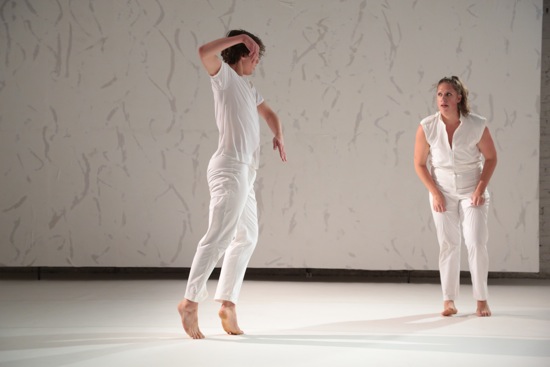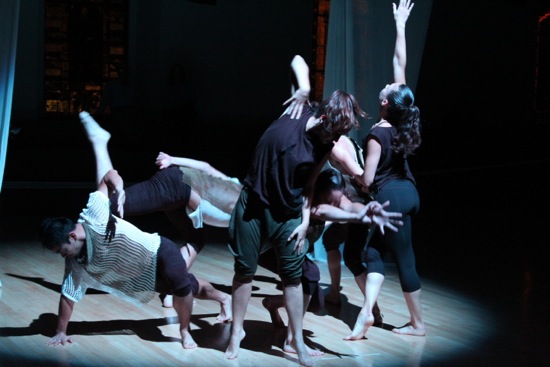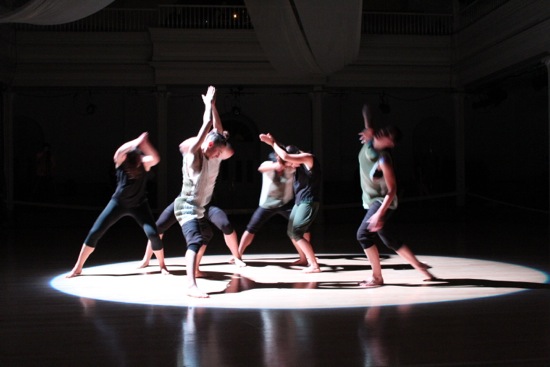Megan V. Sprenger / MVworks at The Chocolate Factory and John J Zullo Dance/Raw Movement at St. Mark’s Church.
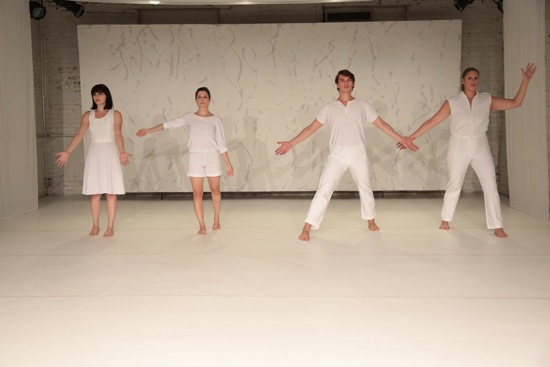
(L to R): Donna Cicchesi, Tara O’Con, Michael Ingle, and Anna Adams Stark in Megan Sprenger’s Flutter. Photo: Madeline Best
When you’re watching Megan Sprenger’s absorbing new Flutter at the Chocolate Factory, you don’t think about butterflies poised above a blossom or birds winging to a new perch. Darker definitions come to mind: restless or uncertain movement, shivery excitement, “disturbance of the rhythm of the heart,” and even, “undesired oscillation in a part of an aircraft under stress.”
At the outset, the four performers (Donna Cicchesi, Michael Ingle, Tara O’Con, and Anna Adams Stark) stand in various stiff-armed positions, lined up across the back of a gleaming all-white space. The floor, the walls, the clothing (by Naomi Luppescu), the lighting (by Joe Levasseur): white. Four filmy lengths of white fabric are spaced out from the front of the performing area to the back; each reaches from the floor and across the ceiling to hang down the opposite wall. The scenic designer, Brad Kisicki, has also created a panel that hangs on the far wall—a huge painting in which slim, subtle, worm-like gray shapes are spaced irregularly against a white ground.
In this immaculate place, the dancers themselves are like marks on a white page. We have ample time to get to know them. As Jason Sebastian’s sound score begins with a low hum, the four move forward and strike their poses again. This action continues until we could, if we wished, reach out and touch the performers. Changes seep in. Ingle’s big, arms-spread, feet-apart stance shrinks a little with each advance. The others’ positions, too, diminish in scale. Their intentions seem to waver. Their eyes shift. Cicchesi appears to lack confidence in her own assertions.
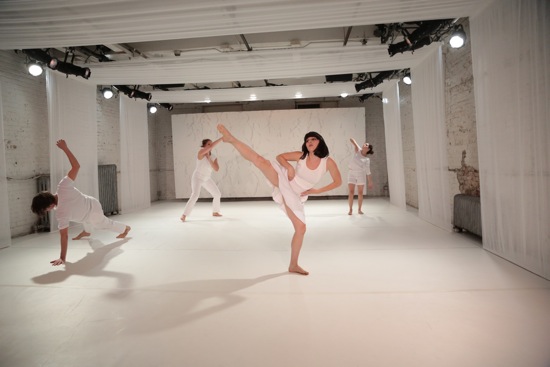
(L to R): Michael Ingle, Anna Adams Stark, Donna Cicchesi, and Tara O’Con in Flutter. Photo: Madeline Best
Very sparingly and stylishly Sprenger metes out variations. Cicchesi turns away from us. O’Con retreats to the rear wall, tries out new poses, then backs toward us. Ingle and Stark adjust and keep coming forward. They all re-group at the back, but on the way, Stark erupts into dancing—a strong, precise, outflung few seconds of it.
As Flutter unfolds, the environment alters. Sometimes the sounds in Sebastian’s score swell, get loud, diminish, change texture. A sweet melody may emerge and be swallowed. Levasseur softens the white light, turns it golden. The dancers shrink and expand their opening poses. Each has bouts of what’s unmistakably full-out dancing, but they don’t sustain these. Almost everything they do is exact, strong, assured, punctuated, even when Stark moves as if she’s throwing an invisible object with great force or Cicchesi lies on her back with her legs shaking, It’s fascinating how the performers’ behavior belies that certainty. Their gaze and the manner in which they change from one activity to another tell us that they are ill at ease in a situation they don’t fully understand and perhaps should be wary of. Often they seem to be trying their movements out.
We watch them for clues or codes, but these are rarely decipherable—like memories that they can’t quite grasp. Stark and Ingle face each other, holding their arms out to the sides. They move into close proximity. Are they trying to embrace? Is one whispering to the other? Does scent play a part in this brief encounter? O’Con flashes a brief grin at a couple of colleagues. Stark grasps Ciccesi’s head. Ingle and Ciccesi stand side by side, leaning this way and that, their hands on their bent knees. She appears to be copying him, watching for changes. Together they breathe; together they increase their speed.
There’s a point at which these fine performers all dance in glaring white light at the same time—big, space-eating gestures of the whole body. Because each one’s moves are different, the effect is of people dancing in a windstorm, yet despite the powerful thrust involved, none of them seems to be losing control. The atmosphere becomes more intense, the music louder, the dancers damper and tireder. But they keep trying things, attempting fleeting interactions and interventions. Something about their lives in this compelling dance that Sprenger has made in collaboration with the dancers (plus contributions from Megan Madorin, Kendra Portier, Yarden Raz, and Alli Ruszkowski ) seems predetermined. Gradually, one by one—as if each of them has an inner timer that has just gone off—the four performers leave the white, white space. You want to say, “Wait! Tell me more. Is this really goodbye?”
When a choreographer calls his company John J Zullo Dance/Raw Movement, you have to think about what he means by “raw.” I don’t think Zullo conceives the word in the sense of uncooked, because, judging by the program notes for the group’s appearance at St. Mark’s church and from what I observe, he wants the choreography to reveal its structure. Nor do the occasional entanglements in the three dances he showed at St. Mark’s church call “Monday Night Raw” to mind. But the three pieces that I saw at a dress rehearsal in the church show dancing in a raw state—deliberately bluff, powerful, unrefined, and executed at an almost unvarying pitch of intensity. I thought of the word “brutal”—hard on the dancers’ bodies—and brute force. As in, why carefully turn a door handle when it’s more fulfilling to break the door down?
At the dress rehearsal, the white bands of fabric that wind around the pillars and enclose the three-sided performing area are not raised to their slightly concealing height. The dancers step over these, rather than ducking under them. But the hanging panels of filmy fabric for Zullo’s 2012 ALL what THIS do HAS you HAPPENED see? BEFORE are in place. Jillian Sawyer is dancing for Mary Madsen in this first piece, and Madsen is absent from the last one. The audience members who will be invited into the last minutes of ALL what are represented by various performers on hand for the final project Xiii, and they are led from their seats to see individual performers up close or view them through the panels (initially caught up, later let down to hang vertically).
Zullo wants us to perceive repetition in ALL. And we do. To various abrasive musical selections, Jeff Davis, Bong Dizon, Jenna Liberati, Olivia Orozco, and Tyler Patterson hurl themselves into moves that recur, appear in different contexts, and are performed in unison or in a kind of scrambled counterpoint. We learn to recognize the heavy-footed runs, with the dancers bending forward and lifting their legs high behind them. We become familiar with the pointing elbows, the “jumps” that the dancers perform while lying on their backs, and other items in the considerable vocabulary of steps. Sometimes the performers pause or slow down; sometimes they don’t all work at the same time. There are occasional brief solos. At one point they cluster somewhat menacingly around Liberati in the circle of light that Mark T. Simpson lays on the floor. However the dynamics of the choreography rarely, if ever, alter, nor do many of the steps appear to connect in any deeply physical way with what came before. After a while, I find myself tuning out, or asking myself, “Why are they doing what they’re doing?”
Clear plastic panels, paired to balance in an inverted V shape, pit the space for this Exquisite diversion/mysterious Skin. In this piece, Zullo attacks memory from a different perspective—a psychological one; some people block especially horrific experiences via amnesia. Zullo has drawn ideas from Scott Heim’s book Mysterious Skin and the film that followed it. The tale is one of child abuse by a school coach and how two of his victims ended up. The sound score (by David Englehard and Zullo) is again stitched together from a variety of works (Olafur Arnalds, Max Richter, et al), and Jessie Davis speaks text from the book either from offstage or among the performers (Mike Hodge joins Davis, Dizon, Liberati, Orozco, and Patterson). The problem is that church’s acoustics can muffle spoken words. Because I understand almost nothing of what Davis is saying (although I hear some of the words when she sings “Dream a Little Dream of Me”) and haven’t yet read the press release, I have no clear idea about what’s going on.
Zullo abstracts the idea of victims and their oppressor. The dancers writhe, fall into a pile, crouch abjectly. They paired up in difficult ways. Patterson wrenches himself around atop a living mattress of his colleagues. Liberati feels her body as if she were blind and seeks reassurance that she exists. Do the transparent plastic panels mirror the action, or conceal or distort the truth? The most thought-provoking moment comes when the dancers partially undress and huddle together on the floor.
Project Xiii is a series of solos by all the performers we’ve seen so far, plus Maria Breza, Adrian Galvin, Alex Martin, Jeff M. Rebudal, and Zullo. Twelve in all. A timer with large, glowing red numerals is placed in the middle of the space and set at 13:00. As it counts down, each cast member performs his or her own 60-second variation on the hard, fast, raw one that Zullo lays out. Each has chosen a different musical extract. If I remember correctly, Hodge dances his intriguingly juicy, knotty little piece to Etta James singing “A Sunday Kind of Love.” All the solos are repeated simultaneously in the last minute. Because Zullo’s theme is so unvarying in its dynamics and its big, whole-body moves, it’s difficult to parse the variations. However, you have to appreciate his generosity in giving each dancer a moment in the limelight to approach the rough-edged movement creatively.

